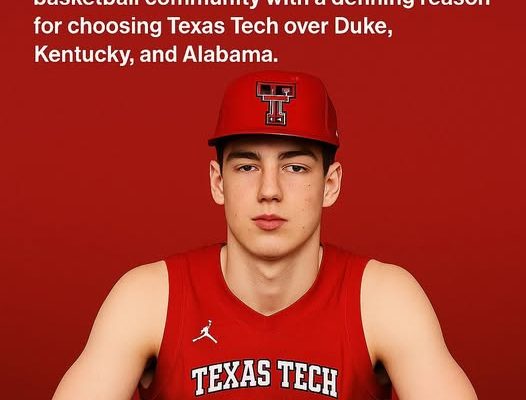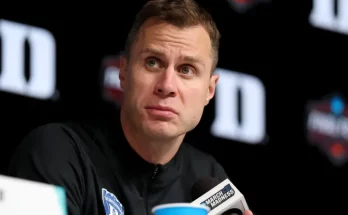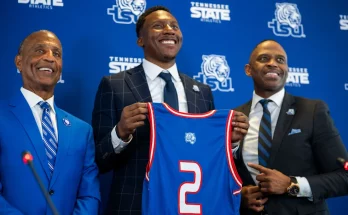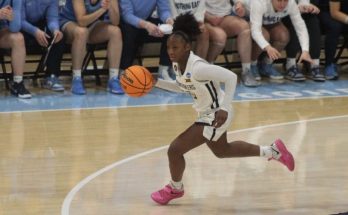The college basketball world has been shaken to its core as the No. 1 overall high school basketball player in America, widely considered a generational talent and transcendent future NBA prospect, has officially committed to the Texas Tech Red Raiders. This stunning development has left fans, coaches, and analysts scrambling to process the implications of such a seismic recruiting win for a program that, while consistently competitive in recent years, has never landed a player of this caliber. Adding even more intrigue to the news is the revelation that the top-ranked player turned down basketball blue bloods including Duke, Kentucky, and Alabama to make his way to Lubbock. It’s a decision that rewrites the script not only for Texas Tech’s future, but also for how elite prospects may begin to view their options in the evolving college basketball landscape.
The commitment was made official on a Tuesday afternoon press conference streamed live on multiple platforms, drawing hundreds of thousands of viewers who were already buzzing with anticipation following a cryptic tweet from the player the night before. Standing at 6-foot-9 with a 7-foot wingspan, the dominant four-star power forward from the class of 2026 (who many believe should be a five-star) didn’t just casually put on the Texas Tech cap. He made a powerful statement—verbally and symbolically—declaring that his decision wasn’t just about tradition, facilities, or NIL money, but about something deeper. He said, “I’m going to Texas Tech because they believed in me before the rest of the world did. They didn’t sell me a dream. They showed me a plan.” It was a line that instantly went viral and resonated with young athletes across the country who have grown tired of the well-rehearsed recruiting pitches from legacy programs that sometimes emphasize brand over fit.
What makes this commitment so captivating is not just the fact that Texas Tech beat out national powerhouses, but how they did it. The coaching staff, led by the relentless and innovative head coach, went all-in on a recruitment process that emphasized player development, one-on-one mentorship, and a system designed to allow elite talents to thrive immediately—not just in college, but in preparation for the NBA. While schools like Kentucky flaunted their history of one-and-done lottery picks and Duke leaned on the legacy of Coach K’s successor and a long line of five-star commitments, Texas Tech took a different route. They built a relationship based on trust, transparency, and belief in the player’s uniqueness. Sources close to the recruitment say that Tech coaches made multiple trips to see the player at his high school and regularly had video calls breaking down film of NBA power forwards to show how they envisioned tailoring their offensive and defensive schemes to his style of play.
This player, known for his electrifying dunks, midrange touch, and defensive versatility, will now walk into a program where he won’t have to share the spotlight with a horde of five-star teammates vying for draft position. Instead, he’ll be the undisputed cornerstone, the face of Texas Tech basketball’s future. One scout who has followed his development closely said, “If he had gone to Kentucky or Duke, he’d still be great, but he might not have the room to be this great. At Tech, they’re giving him the keys to the car and telling him to drive however fast he wants.”
Alabama was considered a frontrunner for much of the early stages of recruitment, leveraging a combination of NIL strength and their recent success in the NCAA Tournament. Kentucky, with its pedigree and the allure of Rupp Arena, was also a major contender, as was Duke, which even hosted the forward on an official visit just two weeks before the decision. But in the end, it was the consistency and personal attention from Texas Tech that made the difference. The player’s inner circle noted that while the other programs brought glitz and glamour, only Tech brought patience and precision. “They came with charts, with ideas, with conversations about what life after basketball looks like. That stuck with us,” said a family member.
This recruiting coup already has ripple effects being felt across the college basketball map. Other elite players from the class of 2026, many of whom have spent the last two years closely watching the recruiting decisions of their peers, are now taking a closer look at programs they previously hadn’t considered top-tier destinations. Coaches from around the country have privately admitted that Texas Tech’s success with this recruitment might signal a new era in which player-centric development and sincere relationships matter more than brand reputation or TV exposure. If this player reaches his full potential under the Red Raiders’ system and becomes a top pick in the NBA Draft, it could spark a trend of more top prospects rejecting the traditional recruiting hierarchy.
On social media, the response has been overwhelming. Red Raiders fans erupted with joy, flooding Twitter, Instagram, and message boards with celebratory posts, highlight reels, and welcome messages. Some even dubbed the commitment as “The Decision 2.0,” referencing LeBron James’s iconic televised commitment to the Miami Heat. One longtime fan wrote, “This is the biggest moment in our program’s history. We’re not just playing with the big boys anymore—we ARE the big boys.” Meanwhile, fans from Kentucky, Duke, and Alabama were left stunned, many questioning how such a top-tier player could escape their grasp. Speculation about NIL deals and backdoor promises immediately flooded the internet, but all indications from the player’s camp point to this being a decision rooted in vision, not just valuation.
College basketball insiders have compared the forward’s skill set to a mix of Giannis Antetokounmpo’s athleticism and Chris Bosh’s finesse, though he himself has said he models parts of his game after Kevin Garnett for his defensive intensity and leadership. His averages last season included 25.2 points, 12.8 rebounds, 3.1 assists, and 2.5 blocks per game, all while leading his team to a state title and earning MVP honors at multiple national tournaments. It’s no exaggeration to say that Texas Tech may have just landed a program-altering player who will not only dominate on the court, but transform how the school is perceived across the national basketball conversation.
The next step for the newly committed star is to finish his final two years of high school with the pressure of the nation watching. That spotlight will only intensify now that his college decision is locked in, and every game, every highlight, every slip-up will be scrutinized. But by all accounts, this is a player built for that pressure. Those close to him describe a mature and grounded individual who thrives under expectations and relishes the chance to silence doubters. He has already begun training with a personal development team that includes former college coaches and professional trainers to prepare him not just for high school dominance, but for the collegiate level and beyond.
This decision also comes at a critical time for Texas Tech, which has been working hard to reestablish itself as a true contender following their 2019 National Championship game appearance. With this commitment, the Red Raiders signal that they’re not just interested in making a tournament run—they want to compete for titles year after year. The player’s presence will likely elevate not only the team’s performance, but also its recruiting profile. Already, multiple four- and five-star prospects have reached out to Texas Tech staff to inquire about the direction of the program and how they might fit alongside the newly committed star.
Ultimately, this landmark moment will be remembered not just for the surprise commitment, but for what it represents: the shifting tides in college basketball recruitment. In an age where athletes are more empowered than ever before, this decision underscores that the road to greatness doesn’t have to follow the same old path. By choosing Texas Tech, the No. 1 high school player in the country has boldly declared that he’s not chasing legacy—he’s building one. And with the entire basketball world now watching, he’s got every opportunity to make that vision a reality.



